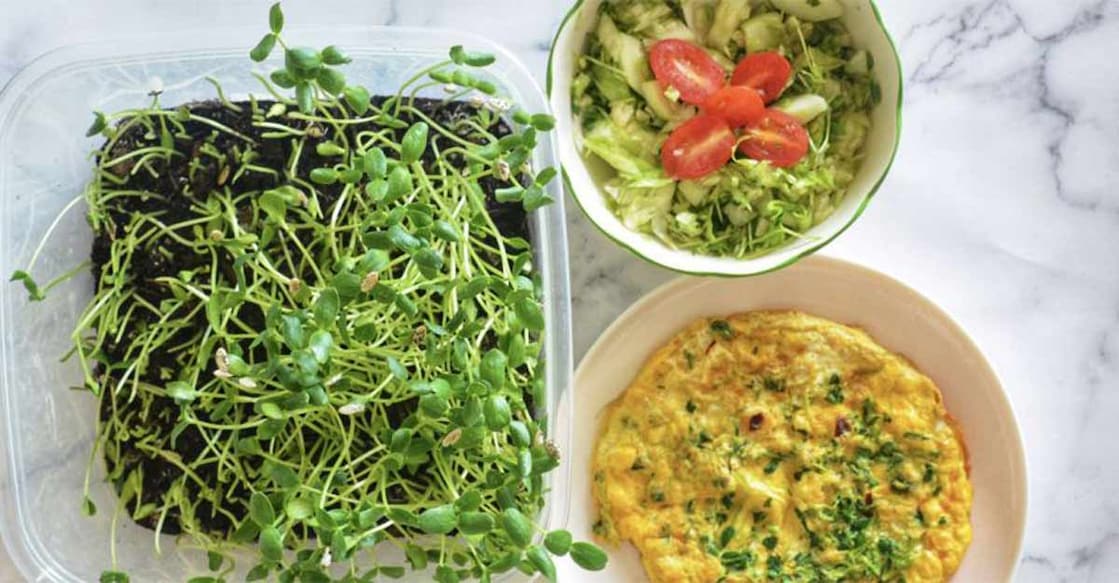Feast on microgreens in the time of COVID-19

Mail This Article
Microgreens are young, baby plants and leaves that are high in nutrients. They can be eaten and are often sprouted from seeds, vegetables or even plants. They grow to just about one to three inches in height and can be farmed anywhere, everywhere, under all climatic conditions and wherever a tiny patch of moisture can be found. They are somewhere between a sprout and a very young plant.
The best thing about the nutrients-packed sprouts is that they can be added to all kinds of dishes. They can be had with every meal of the day. Throw a handful while whisking up an omelette, or add some to your dal curry or salad. Growing them is no big deal as they can be raised them from the seeds of the ash gourd, pumpkin or pea which are otherwise thrown into the trash can.
What exactly is a microgreen?
They are young, tiny and tender leafy greens that sprout from seeds. Though deceptively tiny, their nutrient content would put grownup plants to shame.
Apart from a huge content of Vitamin A, microgreens are rich in potassium, iron, zinc, magnesium and copper. They are heavy in beta carotenes and anti-oxidants. Research says that microgreens contain nine-fold deposits of vitamins and minerals over other full grown plants and vegetables.
Everything from green gram to Bengal gram, methi (uluva), mustard, barley and oats can be grown to yield microgreens. They can also be had from vegetable seeds the moment they begin to sprout.
The tiny leaves can be cut any time between seven and 21 days of sprouting, that is, soon after the first true leaf comes out. Add a bunch of sprouts to your thoran, dosa and chappathy and you have a plate full of natural vitamins to boost your immunity. They are ideal in salads too.
Wheat grass juice that comes from extracting the free-flowing liquid from wheat sprouts is touted to be an anti-aging elixir. However, the sprouts need to be cut, cleaned and whirred for the juice within the week they come up, else, the juice will not go down well. It will be impossible to drink it.
How to grow microgreens
These tiny leaves can be grown in so many ways …. in grow bags, empty parcel boxes, jam bottles and even in flat trays. Drill a few holes in the vessel or box of your choice and fill it lightly with sand. As the roots don’t run deep, even flat plates or trays can be used.
Soak the seeds during daytime for at least eight hours. Take them out at night, wrap the seeds in cotton and leave them overnight to sprout. Keep them moist by sprinkling water droplets till they sprout in full.
Once the seeds have sprouted, scatter them over the soil bed. They should be lightly sprinkled with water twice a day to keep them moist. Those living in apartments can grow the greens indoors. The only condition is that once the leaves come out, they will need their daily dose of sunlight for anything between 12 to 16 hours.
Microgreens can be had to one’s fill. They have no side effects or toxic outcomes. On the contrary, plentiful helpings of microgreens have the power to ward off heart ailments, Alzheimer’s, diabetes and even certain types of cancers. But care should be taken to see that the greens are raised in safe and hygienic environs.
Though the chances of greens producing toxic effects are next to nil, a wee bit of care and attention, especially in these hazardous Corona times, would go a long way in ensuring sound health and immunity.
Details courtesy: Dr Anitha Mohan
Nutrition expert
Thiruvananthapuram

